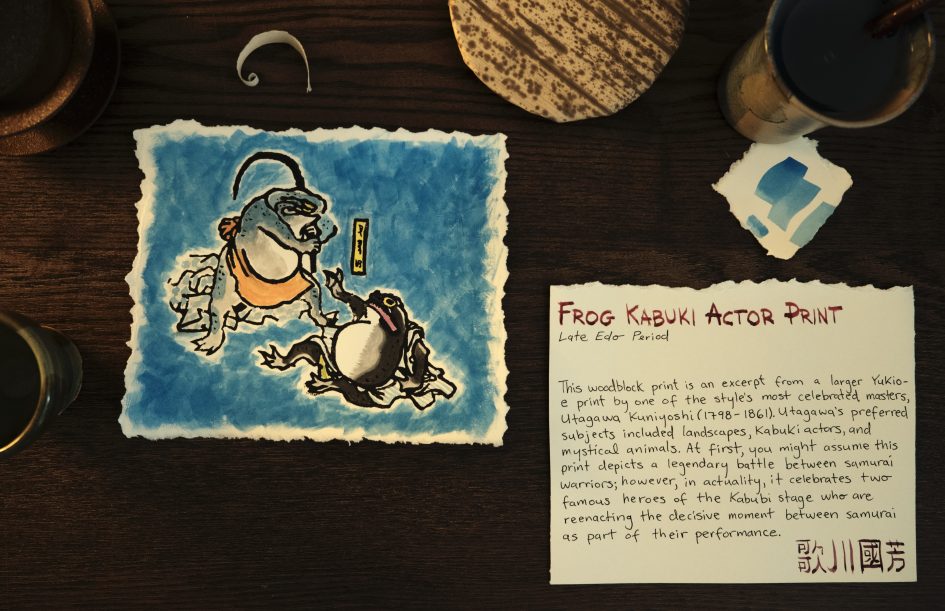
When presented with the brief for this project, I thought it might be fun to carve my own template for a woodblock print. Still, it took me a few days to decide I wanted to attempt a Japanese-style print. I was a bit intimidated, but more than anything, I just wanted my very own Ukiyo-e style print! Contrary to most European style prints, the Japanese Ukiyo-e style prints include a lot more complexity and colour. I was a bit intimidated, but I thought I could pull it off.


After researching for a few hours, I discovered an incredible series of Ukiyo-e prints by the Japanese master Utagawa Kuniyoshi. He created many pieces in varying styles, but I loved his depiction of what appeared on the surface to be samurai frogs in the midst of battle. The original work was pretty big, so I decided to focus on just one of the scenes from this larger piece.

Having never created a print before, my next stop in research was Opus Art Supplies. Here, I was lucky to meet an artist who had created linoleum prints before. They helped me understand the process better and suggested I paint the print by hand after laying the outline. That solved my concern that I wouldn’t be able to create my print in color because of the complexity and cost of materials needed to complete multiple layers. I gathered the required materials and got to work at home.

I have to shout out to my colleague Ava who suggested I create my print with easy cut linoleum. If I had tried to carve this in wood, I wouldn’t have completed this project in time. Even with lino, I vastly underestimated the time it would take to create the outline template for this print. It took me eight hours to carve the template in easy-cut linoleum. I can’t say I have ever experienced such a tedious process in my life. It was painful at times, but after a few days, it was complete. I felt triumphant—time to print.
Luckily, printing was a breeze! After a few quick test prints, I prepared my chosen parchment paper for the final print. I decided on a textured, cream coloured printing paper that fit the era of the piece I was recreating. Afterward, I applied gouache to fill in the colours. I wasn’t quite satisfied with my first attempt painting in the colours, so I decided to create a second print and try again. I’d come this far I thought; I might as well go all the way. After several hours of painting, I finally held the object of all my hard work. It was beautiful! There are undoubtedly little details I would have liked to improve on in a third attempt, but I must say I am incredibly pleased with the final piece. I put a ton of hard work and love into this print, and I’m going to hang it by my desk.

Last on the list was completing my museum label and tabletop photo. I hand-painted the title for the museum label and printed the original artist’s name in Japanese in the bottom right-hand corner. For the photo, I assembled some props I had lying around the house that fit the scene: paintbrush, paper scraps, print pressing tool, and of course, the gaiwan for brewing tea and a teacup. I intentionally lit the photo, so it looks like the artist was painting by candlelight and used a table with a period-appropriate natural wooden finish.
The artifact project was my favourite school project so far. Not only did I discover a new art form I love, but I also learned a ton about a period of history and a culture I admire. Japanese prints are incredibly challenging and time-consuming to make. I can’t imagine what it was like for the original artists, and I’m extremely grateful I had the opportunity to create a print.
I spent over 16 hours on this project from start to finish and can honestly say I’d give myself a 9/10. There’s always a little room for improvement. Still, considering the amount of effort, execution, commitment to quality (creating two prints to get it right), and a well-thought-out stylized photo representing the work and the period befits the grade.


Witten References:
https://en.wikipedia.org/wiki/Woodcut
https://en.wikipedia.org/wiki/Hashira-e
https://en.wikipedia.org/wiki/S%C5%8Dsaku-hanga
https://en.wikipedia.org/wiki/Utagawa_Kuniyoshi
Video References:

Leave a Reply